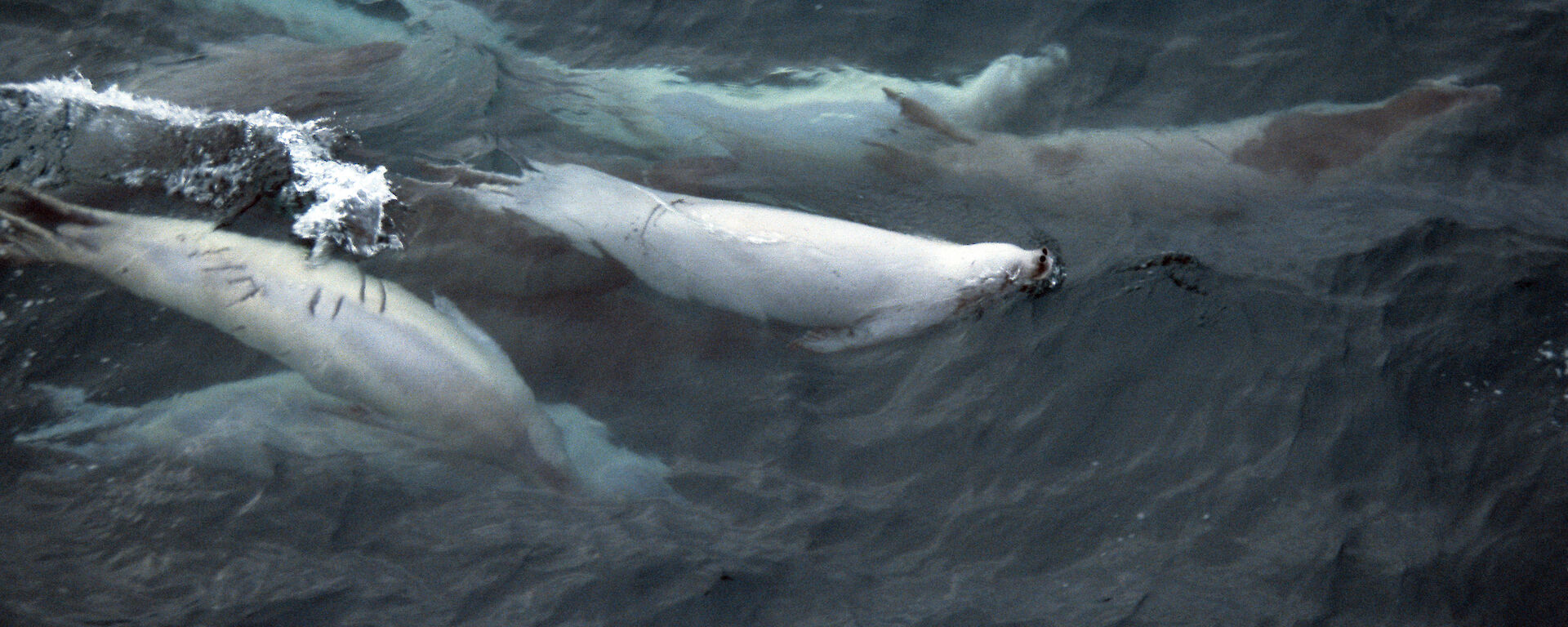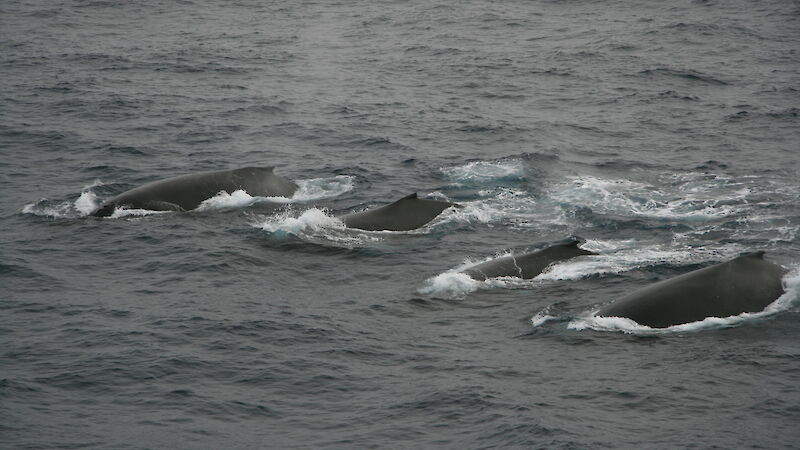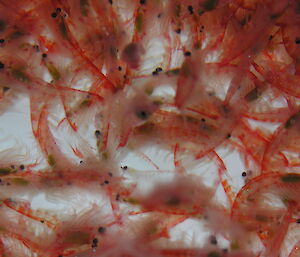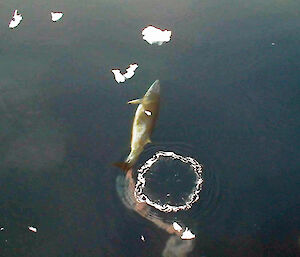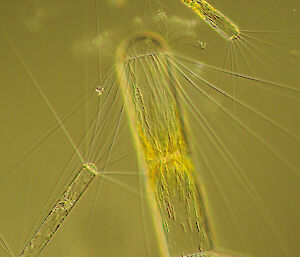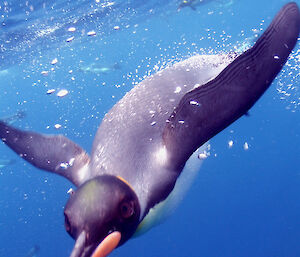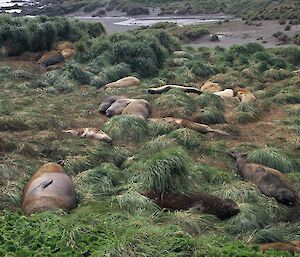Picture an ocean that is teeming with life. The sky is darkened by massive flocks of birds, giant whales cloud the air with the vapour from their blows and from horizon to horizon schools of fish break the surface to escape myriad predators hunting them from every angle. This is not some imaginary scene or a description of a distant ocean paradise; it is culled from descriptions of the marine environment before the large-scale hunting and fishing of marine animals — particularly the large ones. Based on historical accounts, today’s oceans are a shadow of their former state and have lost their ability to support such an abundance of life. Although there have been changes in the physics and chemistry of the ocean over the last century, these alone are unable to explain why the removal of the largest marine animals should be accompanied by a drop in overall marine productivity. A number of recent studies, however, suggest that larger and more abundant animals may play a critical role in maintaining and enhancing marine productivity.
To begin to understand the role of animals in marine productivity we need to understand the role of primary producers — the single-celled plant communities, or phytoplankton, that grow in the surface waters. It is in this well-lit surface layer or ‘euphotic zone’ that most production (the conversion of light into organic matter) occurs through photosynthesis. Nutrients — often in the form of particulate matter — also enter this zone from rivers and erosion, from the atmosphere (either as dissolved gasses or dust from land), from the sediments on the sea floor, and through upwelling of nutrients from deep water. These nutrients, such as carbon, nitrogen and iron, also help fuel phytoplankton growth.
In summer the warm euphotic zone is separated from the cooler, denser water below by a boundary layer known as the ‘thermocline’. Gravity constantly pushes both the phytoplankton and particulate matter downwards, and once they sink below the thermocline they are usually lost to the surface ecosystem. The process of removing nutrients from the surface to the deeper ocean is known as the ‘biological pump’. The balance between the nutrient inputs and losses and the efficiency of nutrient recycling in the euphotic zone determines the productivity of the oceans. So what role do animals play in this process?Until recently, the primary role of animals was considered to be as consumers of carbon and other nutrients, which are converted to fast-sinking faecal material. This process speeds up the sequestration of carbon in deep water and is thought to be responsible for removing a significant proportion of the carbon fixed by plants in the surface layer. But new research is showing that animals are more than just carbon transformers.
Nutrients on the up and down
Nutrients that fall into deeper water are assumed to be lost, but many animals inhabit water far deeper than the euphotic zone. This means they can access deep supplies of particulate matter (and other animals) and bring it back to the surface to re-mineralize the surface layer. For example, vast numbers of marine animals ranging in size from microscopic copepods to large fish undergo diurnal (daily) vertical migrations, usually remaining deeper in the water during the day and visiting the surface at night. This large concerted movement of animals happens every day and can involve vertical movements of thousands of metres.
Another example is sperm whales, which feed on squid and fish at great depths, ingesting nutrients that once were captured at the surface by phytoplankton. When the whales return to the surface to breathe and defecate they release nutrients back into the surface layer. Modelling studies suggest that this recycling of deep material might be significant for scarce but essential elements such as iron. On a smaller scale, humpback whales in the Gulf of Maine have been shown to scavenge nutrients below the euphotic zone and release more nitrogen at the surface via defecation than flows in from rivers.
For almost a century, krill have been known to undertake regular migrations within the top 200m of water. Recently, however, scientists have discovered that krill can exploit food supplies through the entire water column. Underwater footage has shown krill near the seafloor at 3500m, apparently feeding on sedimentary material originating from the surface. Increasingly, footage is appearing of krill at depths previously thought well below their acknowledged habitat of less than 200m. This makes them a potentially important biological route for bringing nutrients from the sediments back into the surface layer. Of course the process may also work in reverse, with animals feeding at the surface and defecating at depth.
Turbulence
Animals also contribute to the mixing of water and nutrients across the thermocline by generating turbulence. The first way they can do this is by 'induced drift' – where some of the water is dragged along with their bodies as they move. Calculations suggest this process could induce turbulent dissipation similar in magnitude to that produced by winds and tides. Swimming animals also generate wake turbulence as they move through the water. While small animals may have little effect, dense aggregations of larger animals would have a significant local effect on mixing. These calculations are based on estimates of the current density and abundance of swimming animals in the sea. Historical abundances of larger animals was considerably higher than today, so the effect would almost certainly have been far greater.Recycling
Finally, animals can play a role in ocean productivity through recycling. Recently, we investigated whether whales could fertilise the surface layer of the Southern Ocean by recycling the iron found in their prey (Australian Antarctic Magazine 19: 4–5, 2010).
The Southern Ocean is one of the areas where phytoplankton growth is limited because of the lack of iron in the surface waters (Antarctica is a poor source of wind-borne dust containing iron). Thus, any mechanism that maintains this element in the surface layer and allows it to be recycled would help to maintain productivity.
The basic concept is that large whales consume large quantities of krill, but because they produce blubber rather than iron-rich muscle, they have little need for the iron in their diet. Consequently, this essential element passes straight through the digestive tract and exits the body in a plume of faecal material which acts like liquid manure. Whales could only play a role in recycling iron if, in fact, there is a large amount of iron in their faeces. Recent measurements of the iron content of the faeces of baleen whales indicated that it contains at least 10 million times more iron than the background level in seawater.
Not surprisingly, the flesh of whales and krill also contain similarly high concentrations of iron and at current population levels krill appear to contain about 24% of the iron in the top 200m of the water within their habitat. This iron is incorporated into their tissues and because krill are strong swimmers, they are able to keep this iron suspended in the upper layer of the ocean, in contrast to smaller organisms or inorganic particles which tend to sink. Because krill live for five to seven years, they can also keep that iron in the surface layer for many years, thereby acting as a buoyant reservoir of iron.
Although individual whales contain large amounts of iron, their relative scarcity means that their main role seems to be in converting the reservoir of iron present in the bodies of krill into liquid manure. This fertilizing role is likely to work on a small scale today, but in the pre-exploitation era when there were millions of great whales in the waters around Antarctica in summer, their affect on iron recycling was likely far greater. Interestingly, there are suggestions that when there were more whales, there was also more krill and that phytoplankton productivity would have had to be higher to support all these animals.
A recent study has actually suggested that phytoplankton abundance has declined in eight of 10 oceanic regions over the past century and this decline is especially evident in areas with especially high harvests of whale and seal populations over the past century. If the effect of large animals on the ocean’s nutrient cycles is as great as recent studies suggest, this could be a clue to why the productivity declines when you remove the largest animals from an ecosystem.If whales and krill do (or did) play a major role in recycling iron in the upper ocean, this explains how an ecosystem with more animals in it can also be more productive. Although the Southern Ocean example focuses on krill and whales, there are a host of other animals and other ecosystems, and similar mechanisms may be operating on different scales and with different groups of predators and prey. It is unlikely that the role of animals as buoyant nutrient reservoirs is restricted to the Southern Ocean, or exclusively to the iron cycle.
Engineering ocean productivity
So where does all this leave us? Until very recently, our concept of how the upper ocean works was driven largely by studies of the physics and chemistry. Even the models used to describe how phytoplankton production is sustained were driven by relatively simple concepts relying on mechanistic relationships between the algae, water chemistry and physics, and the light environment. Animals were rarely viewed as a player in the process, other than in a negative sense.
It is now apparent that animals, particularly larger animals, may play a very important role in sustaining production in the ocean. This would not surprise terrestrial ecologists who deal with ecological communities where the larger animals can play a major role in maintaining the ecosystem on which they depend. This process has been referred to as ecosystem engineering. The open ocean is somewhat different from other ecosystems, partly because of the dominating force of gravity but also because both the primary producers and the herbivores are generally smaller than on land, thus limiting their ability to affect their physical environment. It is easy to see how an elephant can affect is habitat, but less easy to comprehend the effect of krill on theirs. But this does not mean that such effects do not happen; they just may be more subtle and difficult to measure. It has even been suggested that ecosystem engineering may actually be more important in the pelagic system than it is in terrestrial habitats because of the cumulative effect of a vast array of organisms acting at a number of scales simultaneously.
Modern attempts to understand the roles of larger animals in marine ecosystems are also hampered because of the depleted nature of most large marine animal populations. Given the current low number of whales in the ocean, it is understandable that their ecological role can be viewed as insignificant. In an era when there were orders of magnitude more whales, seals and seabirds, and a concentration of these animals in restricted feeding areas, it becomes easier to accept that they may well have an ecological role that extends beyond that of mere consumers. What is becoming apparent is that large numbers of herbivores and smaller carnivores in pelagic ecosystems, can also play a role in ecosystem engineering, despite their relatively smaller size than the depleted vertebrates. The mixing effects of animal movements and their role in nutrient recycling would act synergistically.The concepts laid out here are merely the beginning of a new way of viewing the role of animals in pelagic marine systems. Quantification of these effects is the next step and the modelling of the combined effects of turbulence, nutrient recycling in the surface layer and the effects of nutrient scavenging from deep water is already under way. Such models can be used to confirm whether the sum of these effects can have a cumulative positive outcome on marine productivity. If these ideas hold water then it will be necessary to revisit long-cherished concepts in marine ecology that suggest that removal of higher order predators would have a beneficial effect on ecosystem productivity. Instead, intact ecosystems could be viewed as finely tuned production systems with intricate feedback loops that serve to maintain that productivity. We would have to be much more careful about choosing the organisms we exploit within these systems, given that the effects of exploitation are unlikely to be simple.
Steve Nicol
Former Program Leader, Southern Ocean Ecosystems
Read more about Steve’s career in this issue: Career in krill offers scientific thrills

